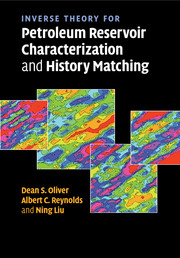Book contents
- Frontmatter
- Contents
- Preface
- 1 Introduction
- 2 Examples of inverse problems
- 3 Estimation for linear inverse problems
- 4 Probability and estimation
- 5 Descriptive geostatistics
- 6 Data
- 7 The maximum a posteriori estimate
- 8 Optimization for nonlinear problems using sensitivities
- 9 Sensitivity coefficients
- 10 Quantifying uncertainty
- 11 Recursive methods
- References
- Index
10 - Quantifying uncertainty
Published online by Cambridge University Press: 06 January 2010
- Frontmatter
- Contents
- Preface
- 1 Introduction
- 2 Examples of inverse problems
- 3 Estimation for linear inverse problems
- 4 Probability and estimation
- 5 Descriptive geostatistics
- 6 Data
- 7 The maximum a posteriori estimate
- 8 Optimization for nonlinear problems using sensitivities
- 9 Sensitivity coefficients
- 10 Quantifying uncertainty
- 11 Recursive methods
- References
- Index
Summary
Reservoir engineers are not typically concerned with the value of permeability and its uncertainty at some particular location in the reservoir. More commonly, they need to quantify uncertainty in some function of all the reservoir variables. They might, for example, require an estimate of time until water-cut reaches 30%, or the oil production rate five years in the future, and the uncertainty in those estimates. In Chapter 8, we discussed computation of the mean and the covariance for linear inverse problems whose posterior probability distributions were multi-normal. We also discussed computation of the mode and a local approximation to the covariance when the problem was nonlinear. In most history-matching applications, the covariance is a relatively poor measure of uncertainty, in which case Monte Carlo methods may be required. By simulating the future performance of many realizations that have been sampled according to their probability of being correct, it is possible to characterize the uncertainty in reservoir production. For Monte Carlo methods, the key to quantifying uncertainty is to generate the samples correctly and efficiently.
In this chapter, we introduce methods of generating realizations from a PDF either unconditional or conditional to observations. We first present methods for unconditional simulation of Gaussian and truncated Gaussian random fields because this is the initial step for many methods of generating conditional realizations.
- Type
- Chapter
- Information
- Publisher: Cambridge University PressPrint publication year: 2008

